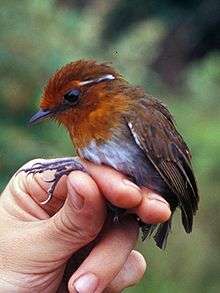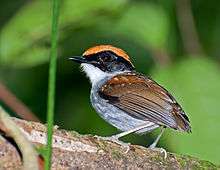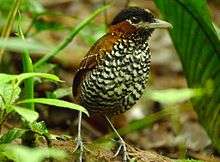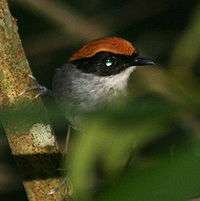Gnateater
The gnateaters are a bird family, Conopophagidae, consisting of ten small passerine species in two genera, which occur in South and Central America. The family was formerly restricted to the gnateater genus Conopophaga; analysis of mtDNA cytochrome b and NADH dehydrogenase subunit 2 sequences (Rice 2005a,b) indicates that the "antpittas" of the genus Pittasoma also belong in this family. The association between this genus and Conopophaga is also supported by traits in their natural history, morphology, and vocalizations (Rice, 2005a). The members of this family are very closely related to the antbirds and less closely to the antpittas and tapaculos. Due to their remote and dim habitat, gnateaters are a little-studied and poorly known family of birds, though they are often sought after by birdwatchers.
| Gnateaters | |
|---|---|
 | |
| Chestnut-crowned gnateater (Conopophaga castaneiceps) | |
| Scientific classification | |
| Kingdom: | Animalia |
| Phylum: | Chordata |
| Class: | Aves |
| Order: | Passeriformes |
| Superfamily: | Formicaroidea |
| Family: | Conopophagidae Sclater & Salvin, 1873 |
| Genera | |
|
Conopophaga Vieillot, 1816 | |
Description
They are round, short-tailed, and long-legged birds, about 12–19 cm (5–7½ inches) in length, with Pittasoma being larger than Conopophaga. They are quite upright when standing. All species are sexually dimorphic, although the extent of this varies greatly. Most Conopophaga species have a white tuft behind the eye.
Distribution and habitat
Gnateaters are birds of the forest understory, bamboo stands, and the forest floor. The members of the genus Conopophaga are found in the Amazon and Orinoco basins, east and central Andean slopes, Atlantic Forest, and nearby regions, while the members of the genus Pittasoma are found in the Chocó, and Panama and Costa Rica. Some species live in impenetrable thickets; others live in more open forest. Most are entirely restricted to humid habitats, but several species extend into drier regions in eastern Brazil. While the members of the genus Conopophaga always are found near the forest floor, seldom rising more than 1.5 m above the ground, they also seldom travel or spend much time on the ground (though they do feed there; see diet). The members of the genus Pittasoma are more commonly seen hopping around on the ground.
Behaviour and ecology
Gnateaters are insectivorous as the group name implies. The members of the genus Conopophaga feed mostly using two methods; one is to perch above the forest floor until prey is spotted, then lunge down to the ground to snatch it; having landed on the ground to snatch a prey item it will not remain on the forest floor for more than a couple of seconds. The second method used is to glean insects directly from the foliage, trunks, and branches of low vegetation. Typical prey items include spiders, caterpillars, insect larvae, grasshoppers and beetles; individuals of some species have also been observed eating fruit and in one case a frog. Very little information is available on the diet of the two Pittasoma, but they are presumably also insectivorous, and have been recorded following army ants swarms.
Species list
Family Conopophagidae:
| Image | Genus | Living species |
|---|---|---|
 | Conopophaga Vieillot, 1816 |
|
 | Pittasoma Cassin, 1860 |
|
References
- Rice, Nathan H. (2005a): Phylogenetic relationships of antpitta genera (Passeriformes: Formicariidae). Auk 122(2): 673–683. [English with Spanish abstract] DOI:10.1642/0004-8038(2005)122[0673:PROAGP]2.0.CO;2 PDF fulltext
- Rice, Nathan H. (2005b): Further Evidence for Paraphyly of the Formicariidae (Passeriformes). Condor 107(4): 910–915. [English with Spanish abstract] doi:10.1650/7696.1 PDF fulltext
- Whitney, B.M. (2003) Family Conopophagidae (Gnateaters) pp 732–748 in del Hoyo J., Elliott A. & Christie D.A. (2003) Handbook of the Birds of the World. Volume 8. Broadbills to Tapaculos Lynx Edicions, Barcelona ISBN 84-87334-50-4
